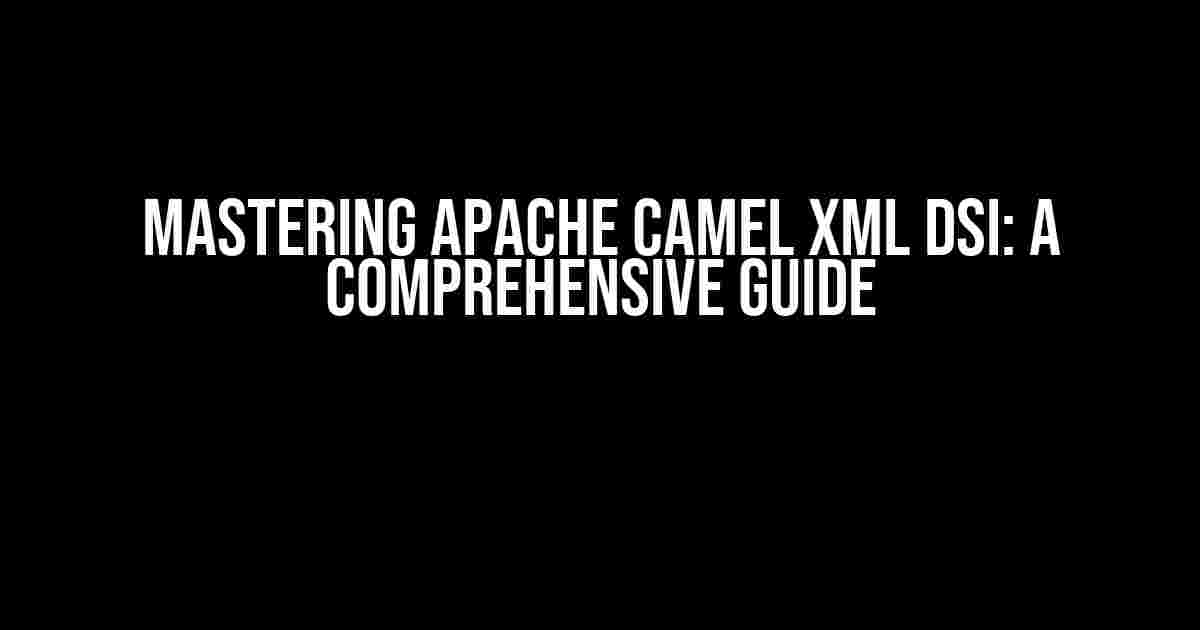Apache Camel is a powerful open-source integration framework that enables developers to integrate various systems, protocols, and data formats. One of the key features of Apache Camel is its ability to define routing rules using XML. In this article, we’ll delve into the world of Apache Camel XML DSI (Data Source Interface) and explore how to harness its power to simplify your integration projects.
What is Apache Camel XML DSI?
Apache Camel XML DSI is a data source interface that enables developers to define data sources and their corresponding routes using XML configuration files. This allows for decoupling of the data source from the business logic, making it easier to maintain and modify the integration flow. With XML DSI, you can define multiple data sources and routes in a single file, making it a powerful tool for complex integration scenarios.
Benefits of Using Apache Camel XML DSI
So, why should you use Apache Camel XML DSI? Here are some compelling reasons:
- Easy Maintenance**: With XML DSI, you can modify the data source or route without affecting the underlying business logic.
- Flexibility**: XML DSI allows you to define multiple data sources and routes in a single file, making it ideal for complex integration scenarios.
- Reusability**: You can reuse your XML DSI configurations across multiple projects, reducing development time and effort.
Configuring Apache Camel XML DSI
To get started with Apache Camel XML DSI, you’ll need to create an XML configuration file that defines the data source and route. Here’s an example configuration file:
<?xml version="1.0" encoding="UTF-8"?>
<beans xmlns="http://www.springframework.org/schema/beans"
xmlns:xsi="http://www.w3.org/2001/XMLSchema-instance"
xsi:schemaLocation="http://www.springframework.org/schema/beans
http://www.springframework.org/schema/beans/spring-beans.xsd">
<!-- Define the data source -->
<bean id="dataSource" class="org.apache.camel.component.datasource.DataSourceComponent">
<property name="driverClassName" value="com.mysql.jdbc.Driver"/>
<property name="url" value="jdbc:mysql://localhost:3306/mydb"/>
<property name="username" value="myuser"/>
<property name="password" value="mypassword"/>
</bean>
<!-- Define the route -->
<camelContext id="myCamelContext" xmlns="http://camel.apache.org/schema/spring">
<route id="myRoute">
<from uri="direct:myEndpoint"/>
<to uri="jdbc:myDataSource?productName=myProduct"/>
</route>
</camelContext>
</beans>
In this example, we’ve defined a data source bean that connects to a MySQL database, and a route that takes messages from a direct endpoint and sends them to the database using the JDBC component.
Defining Data Sources
In the above example, we defined a data source bean using the DataSourceComponent class. Here are some key properties you can configure:
| Property | Description |
|---|---|
| driverClassName | The fully qualified name of the JDBC driver class. |
| url | The JDBC URL of the database. |
| username | The username to use for the database connection. |
| password | The password to use for the database connection. |
Defining Routes
In the above example, we defined a route using the camelContext element. Here are some key properties you can configure:
| Property | Description |
|---|---|
| id | A unique identifier for the route. |
| from | The starting point of the route (e.g., a direct endpoint). |
| to | The endpoint to send the message to (e.g., a database). |
Using Apache Camel XML DSI in Your Project
Now that you’ve created your XML DSI configuration file, it’s time to use it in your project. Here are the steps to follow:
- Create a new Apache Camel project using your preferred IDE or build tool.
- Copy the XML DSI configuration file into your project’s resources folder (e.g., src/main/resources).
- In your Java code, create a CamelContext instance and load the XML DSI configuration file using the following code:
CamelContext camelContext = new DefaultCamelContext();
camelContext.addRouteBuilder(new XmlDsRouteBuilder("classpath:myDs.xml"));
camelContext.start();
In this example, we’re using the XmlDsRouteBuilder class to load the XML DSI configuration file from the classpath.
Troubleshooting Apache Camel XML DSI
When troubleshooting Apache Camel XML DSI issues, here are some common mistakes to look out for:
- Incorrect XML Syntax**: Make sure your XML configuration file is well-formed and follows the Apache Camel XML schema.
- Data Source Configuration**: Verify that your data source configuration is correct, including the driver class name, URL, username, and password.
- Route Configuration**: Check that your route configuration is correct, including the from and to endpoints.
Conclusion
Apache Camel XML DSI is a powerful tool for simplifying your integration projects. By following the instructions and examples in this article, you should be able to create your own XML DSI configuration files and use them in your projects. Remember to troubleshoot common mistakes and take advantage of the flexibility and reusability of Apache Camel XML DSI.
With Apache Camel XML DSI, you can integrate multiple systems, protocols, and data formats with ease, making it an essential tool for any integration developer. So, get started today and experience the power of Apache Camel XML DSI!
Frequently Asked Questions
Get answers to the most frequently asked questions about Apache Camel XML DSL!
What is Apache Camel XML DSL?
Apache Camel XML DSL is a declarative XML-based Domain Specific Language (DSL) used to define routing rules and logic for integrating systems, applications, and services. It provides a way to define routes, endpoints, and processing logic in a concise and easy-to-understand format.
What are the benefits of using Apache Camel XML DSL?
The benefits of using Apache Camel XML DSL include ease of use, flexibility, and maintainability. It allows developers to define complex integration logic in a simple and concise way, making it easier to manage and maintain. Additionally, XML DSL is platform-independent, allowing routes to be deployed on any Java-based runtime environment.
How does Apache Camel XML DSL handle errors and exceptions?
Apache Camel XML DSL provides a robust error-handling mechanism that allows developers to define custom error handlers for specific exceptions. This includes support for try-catch blocks, error handlers, and fault tolerance strategies, ensuring that integrations are resilient and fault-tolerant.
Can Apache Camel XML DSL be used for real-time data integration?
Yes, Apache Camel XML DSL can be used for real-time data integration. It supports event-driven architectures and provides features such as message streaming, event sourcing, and Change Data Capture (CDC) to enable real-time integration scenarios.
Is Apache Camel XML DSL compatible with other Apache Camel components?
Yes, Apache Camel XML DSL is compatible with other Apache Camel components, including Java DSL, Scala DSL, and Spring XML. This allows developers to mix and match different DSLs and components to create hybrid integration flows that meet specific business requirements.


